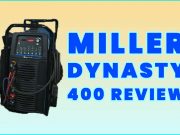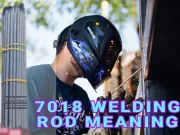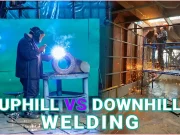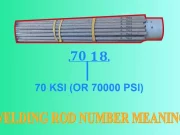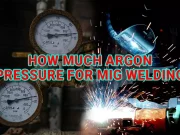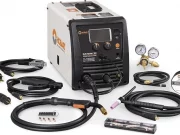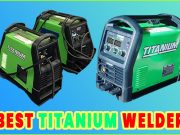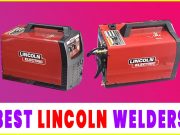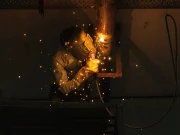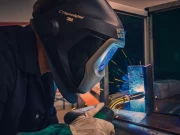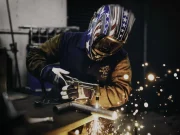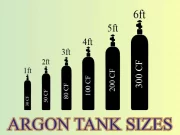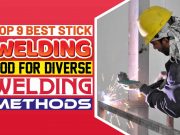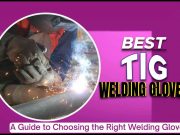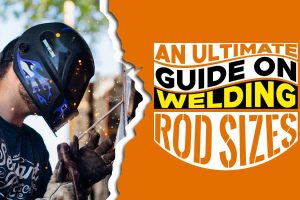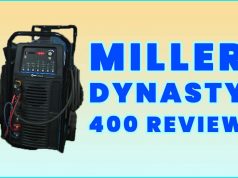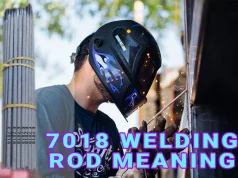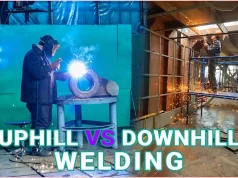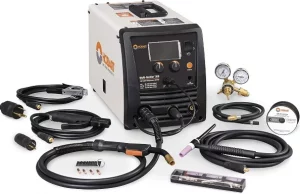Whether you’re a beginner or an established welder, you need to acquaint yourself with knowledge of welding rod sizes.
Welding rods help in joining metals together. They also determine the strength of the bond holding both metals together.
So, choosing the appropriate welding rod size is crucial. That’s because choosing the wrong welding rod would produce a weaker weld. Consequently, all your efforts would be in vain.
You surely do not want that. I, for one, wouldn’t want that too. Welding rod size is a broad topic, and the myriads of rod sizes out there make choosing the right one more confusing.
This guide will discuss different welding rod sizes, types, uses, and many more. So, don’t go away. Continue reading.
Welding Rod Sizes And Classification
It’s not enough to have clues about welding rod sizes. One should also learn about their uses, pros, and cons to make an informed decision.
There are seven sizes of welding rods out there. They are 6010, 6011, 6012, 6013, while the rest is 7014, 7018, and 7024.
It would interest you to know that each of these rods has varied characteristics, such as tensile strength, position, penetration, and others.
Before we go deeper into welding rod sizes, including their uses, let’s discuss welding rod classification.
What does welding rod classification entail?
Before you buy a welding rod, check the rod properly. You’ll find a set of numbers imprinted on it. The numbers mean something, which every welder is supposed to know.
Let’s look at a welding rod with the figures 6010. What does each number entail?
The first two numbers, “60,” represent how much stress the weld beads can handle. Since it’s “60”, it, therefore, means that the rod can take 60,000 pounds per square inch.
If the figure is higher, the rod will be stronger. That’s something you should know.
The third number also means something. Since the electrode used as an example is the 6010, then the third number is “1”.
The third number talks about the position you can use the rod. Since it’s “1,” then you can use the rod in all positions.
The fourth and final number is also crucial. So, don’t neglect it. The number gives an idea of the coating that has been used on the electrode. It also influences the currents one can use.
Here’s a table showing the various welding rod sizes, tensile strength and other crucial information about welding rods.
| Rod specification |
E-6010 |
E-6011 |
E-6012 |
E-6013 |
E-7018 |
E-7028 |
| Coating type | High cellulose Sodium | High cellulose Potassium | High Titania Sodium | High Titanium Potassium | Iron Powder Low Hydrogen | Iron Powder Low Hydrogen |
| Current | DCEP | DCEP AC | DCEP AC | DCEP DCEN AC | DCEP AC | DCEP AC |
| Position | All Positions | All Positions | All Positions | All Positions | All Positions | Flat Horizontal Fillets |
| Penetration | Deep | Deep | Medium | Shallow | Shallow to Medium | Shallow to Medium |
| Tensile Strength – pounds per square inch (PSI) | 60,000 PSI | 60,000 PSI | 60,000 PSI | 60,000 PSI | 70,000 PSI | 70,000 PSI |
Welding Rod Sizes And Their Uses
One reason to learn about welding rod sizes is because of their uses. Each welding electrode is suited to a specific welding project.
If you mistakenly use the wrong welding rod, the weld won’t be appealing or durable. It would be a waste of time and effort for you.
So, here are the various welding rods, including projects they are ideal for.
The 6010 welding rod uses:
This welding rod is suitable for the following welding projects.
- Pipe welding
- Auto body repair projects
- Rusty or dirty metal welding tasks
- Welding joist, including bridging
The 6011 welding rod uses:
You can use this electrode for the following welding projects.
- Pipe welding
- Auto body works
- Building of ship
- Fabrication and general repairs
The 6012 welding rod uses:
This rod size is ideal for the following welding tasks.
- Repair works
- Non-critical welding
- Open joints connection
- Welding of rusted carbon steel sheets
The 6013 welding rod uses:
You can use this rod for the following.
- General repair work
- Building of ship
- Auto body repair tasks
- Worn-out steel welding
The 7014 welding rod uses:
This rod is ideal for the following.
- Farm repair works
- Building of ship
- Auto body repair tasks
- Welding of metal in damp or moist places
The 7018 rod uses:
Here’s what this rod is good for.
- Weapons assemble
- Structural welding projects
- Building construction projects
- Fabrication and general-purpose repair works
The 7024 welding rod:
This rod is useful for the following welding tasks
- Flat fillets welds
- Industrial welding projects
- Large welding projects
- High-speed horizontal welding projects
Essential Things To Consider Before Picking Welding Rod Size
Whatever welding rod you choose should be able to meet your unique needs. This means that you must pay attention to several factors before making your final choice. Now the question is, what are these factors? Why should you even bother to pay attention to them?
If you want your welds to be durable and pleasing to gaze at, you should consider using the ideal welding rod.
Alright, let’s look at factors to consider as you make moves to buy a welding rod.
Factor#1: Current available:
There are two specific options when it comes to current. This includes AC and DC. Some electrodes connect to either or both.
So when buying your electrode, choose one that would be useful, based on the available current in your workshop or project area.
Another thing you need to have in mind is that current influences penetration.
Factor#2: Tensile strength:
Tensile strength is a big deal when buying electrodes. If your rod’s tensile strength doesn’t match the base metal, you’re going to likely experience cracks, including other inconveniences that come with using rods with low tensile strength.
So, check the tensile strength of the rod before splashing the cash. It would be best if you asked this question. Does my rod’s minimum tensile strength match that of the base metal? If yes, then go ahead and splash the cash on it.
How can you determine a welding rod’s tensile strength? It’s simple. We have also shared tips on this at the beginning of this post. But let’s go over it again.
If the welding rod reads 7028, the first two numbers (70) indicate the rod’s tensile strength. In this case, the rod’s tensile strength is 70,000 pounds per square inch.
Factor#3: Welding position:
Welding position is another critical factor that shouldn’t be overlooked. But the good thing is that you can determine your welding rod’s position from the number printed on it.
Look at the third number printed on your welding electrode. If the number is “1”, then the rod can weld in any position. That is horizontal, overhead, vertical, and flat.
However, if the third number is “2”, then the welding position will be horizontal.
Factor#4: Base metal:
The base metal is also crucial. What’s its shape, joint fit-up, and thickness? All these are what you should consider.
If the base metal is thick, your welding electrode should not only boast low hydrogen but be highly ductile. Why? Some may ask this question. Well, the reason is to ensure that the electrode doesn’t end up cracking.
So, if your base metal is a thick one, please choose the appropriate welding electrode. How do you determine which electrode is suitable for your thick base metal? It’s also simple.
You can determine which electrode is ideal for the base metal you’re using via the end digits on the electrode. For better understanding, use rods that end with 15, 16, or 18.
Please keep in mind that the electrode used for thicker base metals is different from thinner metal. For thinner metal, you need electrodes whose penetration is shallow, and the arc is soft. Using a welding rod with deeper penetration will only get the material burnt.
So, if you’re using a thinner base metal, the 6013 electrode is a much better option for you.
Pro Tips: The 6012 welding rod is ideal for wider openings. It’s excellent at making groove welds and bridging such wider gaps. However, if a joint’s fit-up or design isn’t beveled, using the 6010 and 6011 electrodes. These offer deeper penetration and should be able to get the job done satisfactorily.
Welding Rod Types
There is a need for welders, beginners, and professionals to obtain more knowledge on welding rod types. In as much as electrode size matters, types matter too.
The two types of electrodes in existence are consumable and non-consumable electrodes. We’ll be sharing more information on both.
If you prefer TIG welding, the consumable rod is what you should be gunning for. The exception is when using an arc welder together with a carbon electrode.
The carbon rod is non-consumable and comes made of carbon graphite.
Alright, let’s discuss what the two types of electrodes we mentioned entail.
Consumable welding rod:
Consumable electrodes are electrodes that experience significant changes to their structure when used. What this means is that they melt during the welding process. And after melting, the consumable electrode mixes with the weld, making the bond holding both metals in place stronger.
However, consumable electrodes happen to be the most common type of rod out there. SMAW (Shielded Metal ARC Welders) and MIG (Metal Inert Gas) welders use them.
Pro Tip: Stick welder is another name for Shielded Metal ARC Welders.
Your choice on whether to choose a consumable electrode or not depends on the metal you’re welding. Consumable rods are better when used in impurities elimination.
The Non-consumable welding rod:
The non-consumables are different from consumable electrodes in that they don’t melt during the welding process. Examples include carbon and tungsten electrodes.
But the tungsten electrodes, which are used for TIG welding, happens to be more popular than carbon electrodes in residential and industrial applications.
Alright, let’s discuss both electrodes, talking about tungsten and carbon rods.
Tungsten welding rod:
These electrodes, as we said before, are popular than carbon electrodes. They are also used with the TIG welder.
Another unique thing about tungsten rods is how they are made. They are made with either pure tungsten or tungsten and a combination of thorium or zirconium.
Pro Tip: Pure tungsten rods are more suitable for smaller projects where the metals are tiny. These types of projects don’t usually need high amperage.
What’s unique about tungsten and zirconium electrodes? Unlike pure tungsten, you can use tungsten made with zirconium for welding heavier metals. The only thing you have to be wary about is the weld. The bond won’t be as durable as tungsten plus thorium weld.
What’s unique about the tungsten and thorium electrodes? This electrode is the most popular among all three tungsten rods. It uses high amperage and tends to generate a stronger bond.
Here is a table showing the various types of tungsten rods, including identifying them by their colors.
| Tungsten Welding Rod | Color Classification | |
| 1. | Pure Tungsten | Green |
| 2. | 1% Thorium | Yellow |
| 3. | 2% Thorium | Red |
| 4. | 3 to 5% Zirconium | Brown |
Carbon welding rod:
The CAW, or carbon arc welding, has been around for donkey years. It’s also less common in welding shops and home workshops. It boasts an arc welder setup that’s quite different from the standard one in use.
Pro Tip: AWS (America Welding Society) has seized to provide specifications for carbon arc welding.
However, this doesn’t mean that CAW (Carbon arc welding) is no longer in use. It’s just not in vogue anymore.
Carbon arc welding is still being used in the United States military to heat and cut metal to size.
The welder setup will appear weird if you haven’t used this type of welder before. It’s different from the typical welder setup for arc welding.
Carbon arc welding utilizes two non-consumable carbon rods. The rod produces a big arc, making it more challenging to control than other arc welding processes.
But then, this gigantic arc produced gives carbon arc welding a vast advantage. It makes it more ideal for heating metals and cutting channels or holes into metals.
Pro Tip: Carbon arc welding is excellent for welding more extensive metals. But you can’t say the same thing for thin metals. It’s not designed to carry out detailed welds on such metals.
Conclusion
So, these are the welding rod sizes on the market. We also provided details of their classifications, specifications, uses, and factors you need to consider before choosing a welding rod.
Welding rod makes welding possible. Without it, it would be impossible to join metals together. And don’t forget that choosing the right welding rod matters a great deal. It would determine whether your welds would last long or not.

